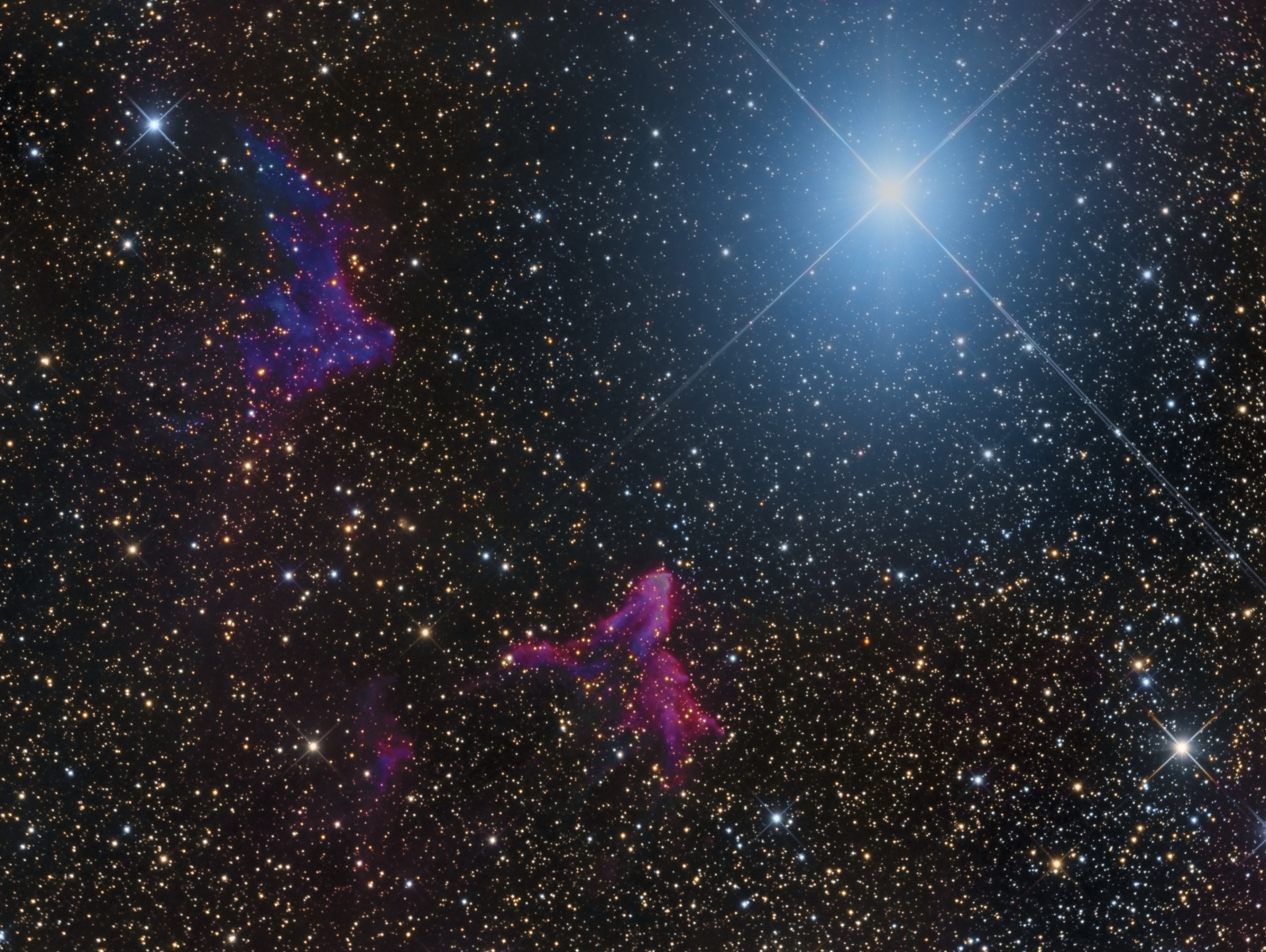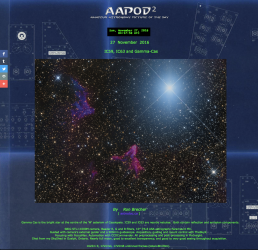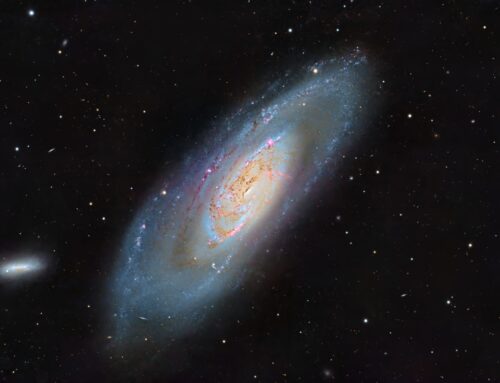γ-Cassiopeia Region
 Click image for full size version
Click image for full size version
September 15, 2016, Amateur Astronomy Picture of the Day, November 27, 2016; Chinese National Astronomy Magazine, Dec. 2016

 In the autumn sky at dusk, Cassiopeia the Queen is low in the northeast, looking like a ‘W’ tipped to the left. The centre star is gamma Cassiopeia (γ-Cas), a very bright star easily visible to the naked eye. Within 3 or 4 light years from this star, and possibly originatingfrom its dust and gas, lie faint nebulae IC59 (upper left) and IC63 (bottom centre). Both emit red light from hydrogen electrons excited by energy from γ-Cas. Both also contain blue features that shine due to γ-Cas’ reflected light. γ-Cas is much bigger than the Sun, about 17 times as massive and with ten times the diameter. Because of this, it radiates about 34,000 times as much energy as the Sun. It is pretty close, compared to my usual targets, at only 550 light years away. The brightness of γ-Cas changes unpredictably; it is a type of variable star known as an “eruptive variable.”
In the autumn sky at dusk, Cassiopeia the Queen is low in the northeast, looking like a ‘W’ tipped to the left. The centre star is gamma Cassiopeia (γ-Cas), a very bright star easily visible to the naked eye. Within 3 or 4 light years from this star, and possibly originatingfrom its dust and gas, lie faint nebulae IC59 (upper left) and IC63 (bottom centre). Both emit red light from hydrogen electrons excited by energy from γ-Cas. Both also contain blue features that shine due to γ-Cas’ reflected light. γ-Cas is much bigger than the Sun, about 17 times as massive and with ten times the diameter. Because of this, it radiates about 34,000 times as much energy as the Sun. It is pretty close, compared to my usual targets, at only 550 light years away. The brightness of γ-Cas changes unpredictably; it is a type of variable star known as an “eruptive variable.”
If you look about halfway between IC59 and IC63 you will see a small peach-coloured nebulous patch. My friend Rick Huziak, sent me information about the object. It is catalogued as Cederblad 4a (Ced 4a), and has various other identifiers in other catalogues. It was discovered by Cederblad in 1946. What is interesting is that it is described as various different types of object: galactic nebula, HII region, and even open cluster. You can find more information at the SIMBAD website.
It certainly was a challenge to keep γ-Cas from overwhelming the comparatively faint nebulae. Making it even more challenging, I acquired the data on the nights of September 13 and 14, under a nearly full Moon.
Tekkies:
SBIG STL-11000M camera, Baader R, G and B filters, 10″ f/6.8 ASA astrograph, Paramount MX. Guided with camera’s external guider and a 500mm guidescope. Acquisition, guiding and mount control with TheSkyX. Focusing with FocusMax. Automation with CCDCommander. All preprocessing and post-processing in PixInsight. Shot from my SkyShed in Guelph, Ontario. Nearly full moon, good to excellent transparency, and good to very good seeing throughout acquisition.
16x10m R, 17x10mG, 17x10mB unbinned frames (total=8hr20m).
RGB
Creation and cleanup: R, G and B masters were cropped and processed separately with DBE. R, G and B were combined to make an RGB image which was processed with ColourCalibration.
Linear Noise Reduction: MultiscaleLinearTransform was used to reduce noise in the background areas. Layer settings for threshold and strength: Layer 1: 3.0, 0.5 Layer 2: 2.0, 0.35 Layer 3: 1.0, 0.2 Layer 4: 0.5, 0.1
Stretching: HistogramTransformation was applied to make a pleasing yet bright image.
Synthetic Luminance:
Creation and cleanup of SynthL: The cleaned up R,G and B masters were combined using the ImageIntegration tool (average, additive with scaling, noise evaluation, iterative K-sigma / biweight midvariance, no pixel rejection).
Deconvolution: A copy of the image was stretched to use as a deconvolution mask. A star mask was made from unstretched SynthL to use as a local deringing support. Deconvolution was applied (80 iterations, regularized Richardson-Lucy, external PSF made using DynamicPSF tool with about 20 stars; local deringing at 70% and global dark deringing at 0.03).
Linear Noise Reduction: MultiscaleLinearTransform was applied to reduce the noise. Layer settings for threshold and strength: Layer 1: 3.0, 0.5 Layer 2: 2.0, 0.35 Layer 3: 1.0, 0.2 Layer 4: 0.5, 0.1
Stretching: HistogramTransformation was applied to make a pleasing yet bright image. TGVDenoise was applied and the image was re-stretched to reset the black point.
Reducing star halo: A large scale mask was made that protected everything except the halo around γ-Cas. The mask was heavily blurred to ensure smooth transitions. The curve tool was used to reduce the brightness of the halo, with the greatest reductions near the centre.
Combining SynthL with RGB:
The luminance channel of the RGB image was extracted, processed and then added back into the RGB image as follows:
1. Extract luminance from the RGB image.
2. Apply LinearFit using SynthL as the reference.
3. Use ChannelCombination in Lab mode to replace the RGB’s luminance with the fitted luminance from step 2.
4. LRGBCombine was then used to make a SynthLRGB image.
Final Processing of SynthLRGB:
MultiscaleLinearTransform was applied to sharpen the brightest parts of the nebula (bias +0.03 for layers 2 and 3), protecting other areas with a mask.
Background, stars and nebula brightness, contrast and saturation were adjusted in several iterations using Curves with masks as required. Great care was taken to protect γ-Cas from getting blown out or interfering with the view of the nebulae.
Image scale is about 1.1 arcsec per pixel for this camera / telescope combination.






Leave A Comment